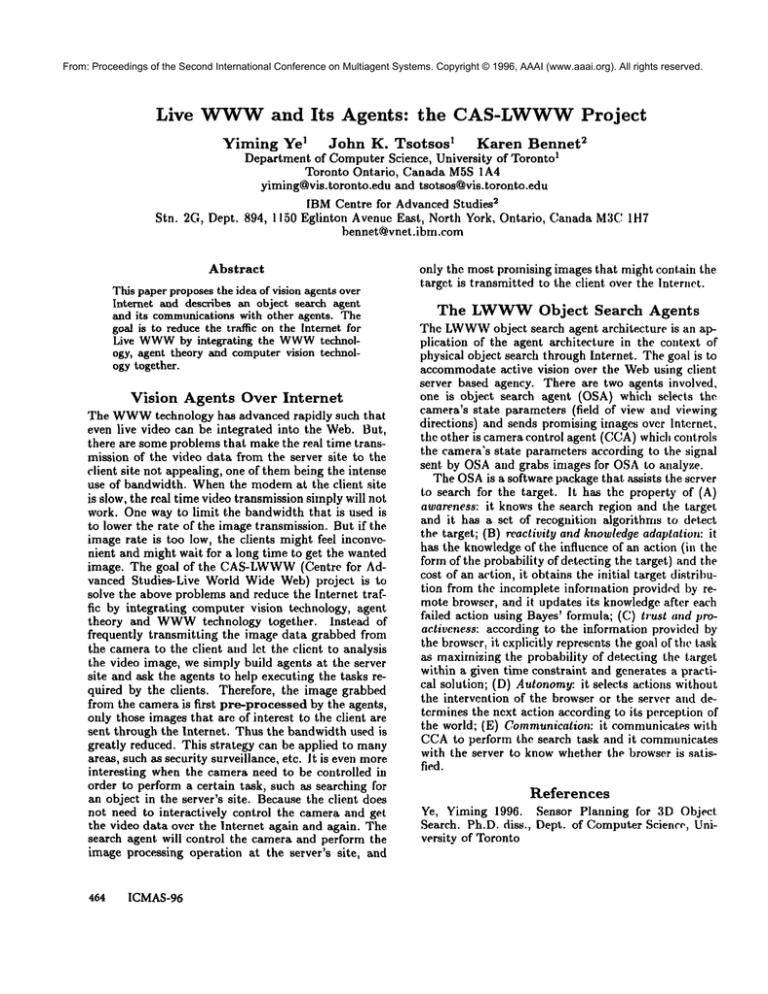
From: Proceedings of the Second International Conference on Multiagent Systems. Copyright © 1996, AAAI (www.aaai.org). All rights reserved.
Live
and Its
Agents:
the
CAS-LWWW
Project
1 2Karen
Yiming
Ye I John K. Tsotsos
Bennet
zDepartment of Computer Science, University of Toronto
Toronto Ontario, Canada MSS1 A4
yiming(~vis.toronto.edu and tsotsos@vis.toronto.edu
2IBMCentre for Advanced Studie~
Stn. 2G, Dept. 894, 1150 Eglinton Avenue East, North York, Ontario, Canada M3CIH7
bennet@vnet.ibm.com
Abstract
This paper proposestile idea of vision agents over
Internet and describes an object search agent
and its communicationswith other agents. The
goal is to reduce the traffic on the lnternet for
Live WWW
by integrating
the WWW
technology, agent theory and computervision technology together.
Vision
Agents
Over Internet
The WWW
technology has advanced rapidly such that
even live video can be integrated into the Web. But,
there are some problems that makethe real time transmission of the video data from the server site to the
client site not appealing, one of them being the intense
use of bandwidth. Whenthe modemat the client site
is slow, the real time video transmission simply will not
work. One way to limit the bandwidth that is used is
to lower the rate of the image transmission. But if the
image rate is too low, the clients might feel inconvenient and might wait for a long time to get the wanted
image. The goal of the CAS-LWWW
(Centre for Advanced Studies-Live World Wide Web) project is to
solve the above problems and reduce the Internet traffic by integrating computer vision technology, agent
theory and WWW
technology together.
Instead of
frequently transmitting the image data grabbed from
the camera to the client and let the client to analysis
the video image, we simply build agents at the server
site and ask the agents to help executing the tasks required by the clients. Therefore, the image grabbed
from the camera is first pre-processed by the agents,
only those images that are of interest to the client are
sent through the Internet. Thus the bandwidth used is
greatly reduced. This strategy can be applied to many
areas, such as security surveillance, etc. It is even more
interesting when the camera need to be controlled in
order to perform a certain task, such as searching for
an object in the server’s site. Because the client does
not need to interactively control the camera and get
the video data over the Internet again and again. The
search agent will control the camera and perform the
image processing operation at the server’s site, and
454
ICMAS-96
only the most promising images that might contain the
target is transmitted to the client over the Internet.
The LWWW Object
Search
Agents
The LWWW
object search agent architecture is an application of the agent architecture in the context of
physical object search through Internet. The goal is to
accommodateactive vision over the Webusing client
server based agency. There are two agents involved,
one is object search agent (OSA) which selects the
camera’s state parameters (field of view and viewing
directions) and sends promising images over Internet,
the other is camera control agent (CCA)which controls
the camera’s state parameters according to the signal
sent by OSAand grabs images for OSAto analyze.
The OSAis a software package that assists the server
to search for the target. It has the property of (A)
awareness: it knows the search region and the target
and it has a set of recognition algorithms to detect
the target; (B) reactivity and knowledgeadaptaLion: it
has the knowledgeof the influence of an action (in the
form of the probability of detecting the target) and the
cost of an action, it obtains the initial target distribution from the incomplete information providc,d by remote browser, and it updates its knowledgeafter each
failed action using Bayes’ formula; (C) trust ~mdproactiveness: according to the information provided by
the browser, it explicitly represents the goal o[ the task
as maximizingthe probability of detecting the target
within a given time constraint and generates a practical solution; (D) Autonomy:it selects actions without
the intervention of the browser or the server and determines the next action according to its perception of
the world; (E) Communication: it communicates with
CCAto perform the search task and it communicates
with the server to knowwhether the browser is sat.iv
fled.
References
Ye, Yiming 1996. Sensor Planning for 3D Object
Search. Ph.D. diss., Dept. of Computer Science, University of Toronto


